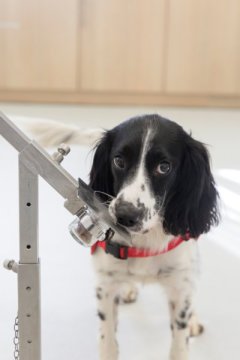"People with malaria parasites generate distinct odors on their skin and our study found dogs, which have an incredibly sensitive sense of smell, can be trained to detect these odors even when it's just on an article of clothing worn by an infected person," said Steven Lindsay, a public health entomologist at in the Department of Biosciences at Durham University in the United Kingdom and the lead investigator on the study.
The research was conducted with colleagues from the London School of Hygiene & Tropical Medicine (LSHTM), the Medical Research Council Unit The Gambia at the London School of Hygiene & Tropical Medicine, and experts from a charity, Medical Detection Dogs. The charity has trained dogs to detect a variety of maladies, including prostate cancer and people at risk of slipping into a diabetic coma.
The canine malaria detection work was supported by a Grand Challenges grant from the Bill & Melinda Gates Foundation, which is seeking, among other things, new ways of diagnosing the disease that are non-invasive and quick. New tools are urgently needed because, after more than a decade of dramatic reductions in malaria infections and deaths, over the last two years the world has experienced a slight increase in both.
Lindsay said the experiment began in The Gambia where several hundred school children, who had been recruited to join the trial, were checked for overall general health, sampled for malaria parasites and fitted with a pair of socks that they were asked to wear overnight. The next day, the socks were collected. The socks were sorted according to the malaria infection status of the children who had worn them. Only socks from children with malaria who did not have fever were selected, as were the socks from the children who were uninfected. The socks were then shipped to the United Kingdom where they were stored in a freezer at LSHTM for several months while the dogs were trained.
For the test, trained dogs had to distinguish between socks from children with malaria parasites and socks from uninfected children. They were trained to sniff each sample and to freeze if they thought they detected malaria, or move on if they did not. Using just the sock samples alone, the dogs correctly identified 70 percent of the infected children and 90 percent of the uninfected children.
The researchers said the accuracy of the dogs was impressive and they were identifying malaria infected children with lower levels of parasites than required to meet clinical standards for rapid diagnostic tests set by the World Health Organization (WHO). However, in the future this work needs to be expanded with more samples tested from different parts of Africa.
But Lindsay said the dogs' success rate actually might have been higher -- up to 78 percent -- if the children with malaria were all carrying the same type of parasites. As malaria infections progress, the parasite goes through several stages of development. And Lindsay thinks that when it reaches a certain stage of maturity, the odor it generates on human skin changes.
Further testing revealed some of the children were carrying these more mature parasites. But the dogs were not trained to detect their odor. Moreover, the researchers pointed out that the success rate potentially could have been higher if the dogs were actually with the children or were working with socks that had been worn recently, instead of samples that had been frozen for several months while the dogs were being trained.
However, Lindsay and his colleagues said their work was only designed to be a "proof of concept study" to show that malaria diagnosis by dogs is possible. They believe that with more training and more samples, the dogs could end up with an accuracy approaching a clinical test. Meanwhile, Lindsay noted that some of the existing clinical tests for malaria are suffering setbacks because mutant malaria parasites are emerging that no longer produce the specific protein those tests are designed to detect.
As for putting malaria detection dogs to work in the field, Lindsay said they could be helpful assistants in a malaria elimination campaign that requires treating anyone in a village or community who is still carrying malaria parasites, including those who are not showing symptoms. Currently, the only way to address the problem of "asymptomatic" carriers -- who still can cause new infections by passing along their malaria parasites to the local mosquito population -- is to test or treat an entire community.
Lindsay said detection dogs could be useful for, at the least, significantly narrowing the focus of clinical testing and treatment efforts. He said detection dogs would operate best at ports of entry into countries which eliminated malaria or are close to elimination. For example dogs could detect people carrying malaria parasites in southern Africa or in places like the East African island of Zanzibar, where efforts to eliminate malaria are complicated by a steady stream of visitors arriving from the mainland where malaria remains common.
In addition, Lindsay believes training dogs to detect specific scents associated with malaria also could inform work underway to develop artificial 'electronic noses' or 'e-noses' that can diagnose diseases based on smell.
Professor James Logan, Head of the Department of Disease Control, at the London School of Hygiene & Tropical Medicine, said: "Worryingly, our progress on the control of malaria has stalled in recent years, so we desperately need innovative new tools to help in the fight against malaria.
"Our results show that sniffer dogs could be a serious way of making diagnosis of people who don't show any symptoms, but are still infectious, quicker and easier."
One survey reports that 33% of dog owners admit they talk to their dogs on the phone or leave messages on answering machines while they are away..
Hi! I am a robot. I just upvoted you! I found similar content that readers might be interested in:
https://www.sciencedaily.com/releases/2018/10/181029102828.htm